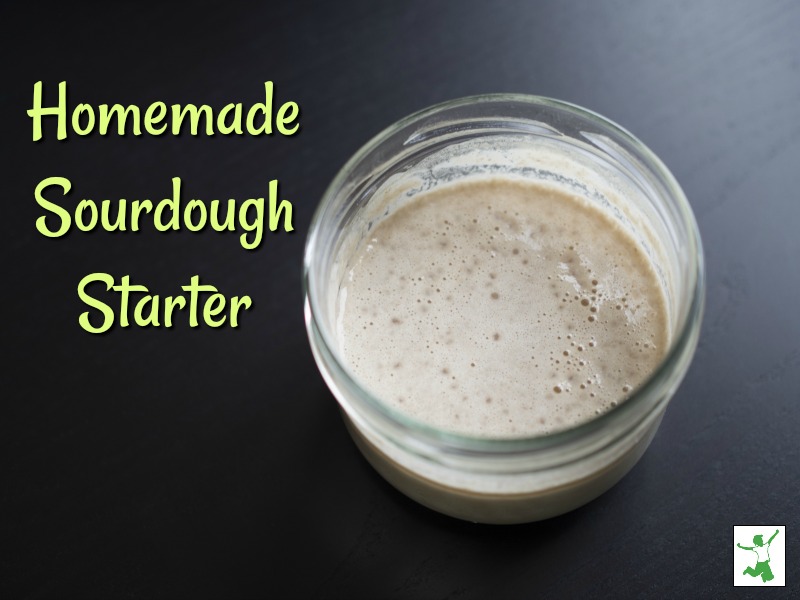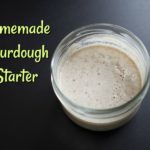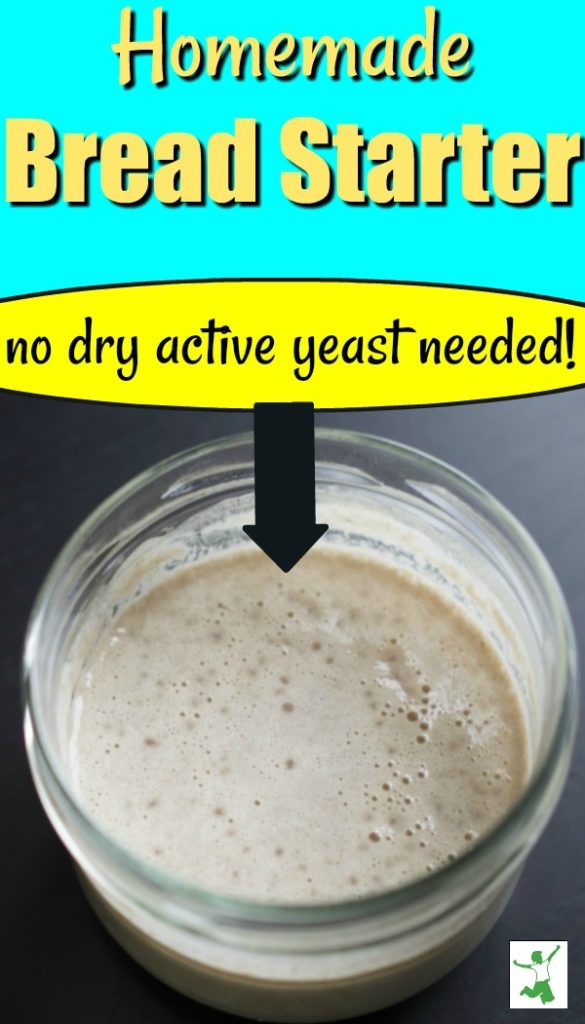Easy to follow homemade sourdough starter recipe to enjoy traditionally prepared, easy to digest sourdough bread made from whatever grain flour you choose. No active yeast required!
When I first got into Traditional Food in 2001, I pretty much had to make anything and everything myself. The reason is because there were few companies (and none in my local area) that made the type of food I was seeking. Worse, few people understood what I was even talking about! This was true even with the perennial favorite sourdough bread. My quest to learn how to make sourdough starter was usually met with puzzled expressions.
“Isn’t using yeast the proper way to get bread to rise? Isn’t this the way it’s always been done?” people would blankly ask.
“If the bread is organic, isn’t that good enough?”
Uh, no, no and no!
Yeast for breadmaking is relatively new in the grand scheme of human history. In fact, when baker’s yeast was first introduced as an alternative to true sourdough starter in France in the mid-1600s, it was strongly rejected. Renaissance scientists at the time knew that this quicker, more convenient approach to breadmaking would negatively affect public health.
Ancestrally prepared bread never contains added baker’s yeast!
Instead, traditionally baked bread utilizes a starter culture loaded with friendly Lactobacilli. This is a beneficial strain of bacteria found on the surface of all living things. Yes, it’s even crawling all over you right now if your skin is healthy and in proper pH balance.
In addition to the absence of baker’s yeast to make the bread rise, true sourdough bread as baked by traditional cultures throughout the world and by my own ancestors in Northern Europe – the type of bread ideal for my personal genome – is baked at a lower temperature for a longer period of time which protects the integrity of the proteins in the cereal grains as well as the nutritional value. This slower, more careful preparation method also eliminates anti-nutrients such as phytic acid. These substances interfere with proper digestion and block absorption of the minerals in the cereal grains. Traditional preparation also helps breaks down gluten, a very difficult to digest plant protein.
Best of all?
When you eat traditionally prepared sourdough bread (not the fake sourdoughs at the store that use yeast), you only eat a little because it is so filling!
The “bread makes you fat” argument is of much less concern when consuming traditionally prepared carbs. Eating the whole bread basket like what happens at the typical restaurant would not happen if those bread baskets were filled with true sourdough (and served with real butter of course!)
Homemade Sourdough Starter
Are you convinced yet that traditionally prepared bread is the way to go if you choose to consume carbs (which I do … I love bread!)
The next step then is to get hold of sourdough starter to try your hand at making a loaf.
Below are the directions I’ve always used to make sourdough starter, adapted, of course, from the must-have cookbook Nourishing Traditions!
Rye Flour Works Best (but you can go gluten free too)
Note that learning how to make sourdough starter really requires freshly ground rye flour. The chances of the starter “taking” are highest going this route.
If you use store-bought flour, even if organic, or another type of grain, it is likely the starter will not take and grow mold before it is ready. I know this from experience!
Note that even if your starter is made from rye, you can still use it to make sourdough bread with whatever flour you like!
To emphasize this point one more time, you will get your best results from making your sourdough starter with rye flour instead of wheat. Once your sourdough starter is ready, you can, of course, bake your bread with whatever grain you like. It’s just best to use rye for the starter alone .. you don’t have to make rye bread with it, in other words.
If you really want to make your sourdough starter with wheat, I would recommend einkorn. It is is the only heirloom wheat left on planet Earth that is completely unhybridized. By comparison, note that heirloom wheat like spelt, Kamut and emmer are hybridized! This is a frequent point of confusion.
Like rye, einkorn is lower in phytic acid and contains an easier to digest form of gluten than modern hybrid wheat. Another point to keep in mind is that while no GMO wheat currently exists on the market, most conventional wheat is toxic due to widespread desiccation practices using glyphosate-based herbicides during harvesting. Organic is going to be the safest choice for this reason.
Note that the total time to make a proper sourdough starter is one week. It doesn’t take much time each day, but you have to give the dough a chance to get “ripe” with lactobacilli.
Buying Bread Starter
It’s true. Making a sourdough culture is not a fast process. Even though it doesn’t take a lot of hands-on time, it takes a full week of waiting to let Mother Nature do her thing. And, sometimes, despite your best efforts, the sourdough starter fails and gets mold on it before the 7 days is up.
If you would rather buy starter to save time, I recommend this quality, vetted sourdough starter brand.
Gluten-free? Use this gluten-free sourdough starter instead.
Both of these types of sourdough starter are available here at 20% off.

Sourdough Starter Recipe
Easy to follow homemade sourdough starter recipe to enjoy traditionally prepared, easy to digest sourdough bread made from whichever grain you choose.
Ingredients
- 8 cups freshly ground rye flour
- 8 cups cold filtered water
- 2 large mixing bowls
- 2 fine mesh cheesecloth
Instructions
-
Day 1: Mix 2 cups flour with 2 cups of cold water. The mixture will be rather soupy. Cover with a *double* layer of cheesecloth secured by a rubber band. This will allow beneficial wild yeasts and bacteria to get into the culture but will keep critters out.
If the weather is good, set the bowl outside in the shade if you live in an unpolluted area and you don't spray any pesticides around your yard. If this is not possible, set the bowl in a warm, open area like an indoor patio.
-
Days 2-7: Every day for a total of 7 days, transfer the ripening sourdough starter to a clean bowl and add 1 cup of fresh flour plus 1 cup of cold water or even a bit more to make the mixture soupy. Cover with a fresh cheesecloth and let stand.
After a few days, you will notice the mixture begin to bubble. It will also smell a bit like wine. The frothy stage will begin to subside and after 7 days, the sourdough is ready for breadmaking!
Sourdough Starter Storage
If you need to go on vacation or take a break from breadmaking for a while, this article on how to store sourdough bread starter can help.
Whether you need to put your starter on hiatus for a week, a month, or even a full year, taking the proper precautions will save you from the process of having to make sourdough starter again later on.
Ready To Make Sourdough Bread?
This recipe for no-knead sourdough is simple and perfect for first-timers. Simply mix the ingredients together before you go to bed. In the morning, form into a rough round and bake for an hour! What could be simpler?
If you choose to buy sourdough bread rather than bake it yourself, I recommend this family-owned bakery that will ship freshly baked sourdough bread to your door.
If you are considering another brand, beware of imitation commercial sourdough! Watch out also for these common sourdough bread myths that continue to make the rounds.
Reference
More Information
Can Celiacs Eat True Sourdough Bread?
Einkorn Sourdough Crackers with Nut Butter
Benefits of Farro









Nice to see this Sourdough recipe, but i;m still waiting for the Baking proces… Can’t make a bread untill I know the full recipe. Thanks!
I’m on my 3rd day and it smells like cheese. Does it mean it’s moldy?
Can I use this base for pancakes?
Yes, absolutely!
I was wondering if you had any opinions about ezekiel bread. I was always under the impression that it was pretty good, but now I am noticing that it has yeast. Thanks
Ezekiel has sprouted grains in it, so using yeast to rise the dough isn’t as problematic as using it for unsprouted flour. That being said, I don’t care for the Ezekiel bread because it has soy in it. I won’t use it for that reason alone.
I’ve also noticed, at least on the ingredients I’ve read, that there is added wheat gluten. kinda defeats the purpose of sprouting!
Yes, good point!
I tend to make sourdough a few times, then let the starter get all dried out and disgusting in the fridge before throwing it away, then I have to start all over again. I had begun a new starter last week and baked my bread yesterday. I love reading how many variations there are to the methods.
I do not eat gluten normally. I can make a great, bubbly, active gf starter, but I have never made gf sourdough that wasn’t a giant inedible brick. I can make great gf bread with yeast, but not sourdough.
With experimentation, I’ve found I can eat einkorn if I ferment it at least 24 hours and not one minute shorter. I grind the Einkorn in my Champion juicer/grain grinder I got for a reasonable price on ebay. I make starter by mixing a big spoonful of einkorn with equal amount water in a mason jar. I stir, cover, and add another spoonful of water/einkorn twice a day. After several days, it’s active and ready to use in a week.
My recipe for one 4 1/2×8 1/2 loaf pan is 3 cups einkorn, approx 1 1/4 cups water, 1/4-1/2 cup starter and 1 1/4 tsp salt. Mix with dough blade in food processor. Put in loaf pan. Cover. Let sit out at room temperature for 24-48 hours. Bake at 450 for 10 min and lower oven to 350 for 40 minutes.
My biggest problem: The dough rises beautifully in the first 12 hours. Then it starts to fall a little over the next 12 hours. When I jostle the pan to move it into the oven, it falls more. It tastes phenomenal and has pretty good texture, but I want it to stay as high as it is at the 12 hour mark and I can’t figure out how to do that. Any suggestions from anyone?
At the 12 hour mark, punch it down and knead it again, reshape it and put it back to rise. It should rise better. If gluten is a big issue, knead it on an oiled board, with GF flour, or with a light dusting of arrowroot or tapioca to keep it from sticking.
I think I read on previous posts that you sometimes use Sami’s bread,, such as their sourdough millet & rice. I’m assuming you think that is a relatively healthy choice for bread. I found one store that carries Sami’s locally, and I like it and like the convenience of it. I developed a gluten free sourdough starter but the breads turned out hard and disappointing and I stopped making it. Can you discuss what you think of some of the store bought breads and store bought sourdough breads?. I just can’t do everything…and want to have a little bread here and there.
Having come from a place years ago where I had to make *everything*, I am so very grateful for places today like Sami’s that make a decent sourdough loaf for me to buy. I am happy to support these local businesses and am more than thrilled to see more and more popping up as the years go by 🙂
Is it at all possible to make Gluten free sour dough starter? That would be amazing!
Wouldn’t you be less likely to get mold if you added the flour and water to the same bowl each day? Constantly transferring to a new bowl would seem to add contaminents making the chance of mold a lot greater.
Sarah,
I have some liquid lactobacilli probiotic in my fridge. Is there any reason why I can’t use that to make my starter?
I don’t think this would work. You need the help of wild yeasts in the air as well.
Yes, purchase rye grain and grind it. A local grain co-op is your best bet. Ask friends who make bread and/or at the healthfood store.